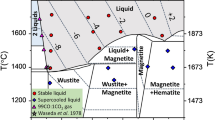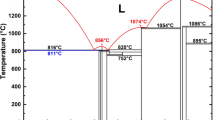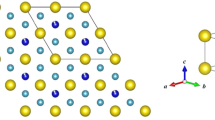Abstract
SINCE the structure of the sigma phase was established by Bergman and Shoemaker1, it has been found in many binary alloys of transition elements (see, for example, Haworth and Hume-Rothery2). Where the phase boundaries have been established, the width of the range of composition varies from less than 1 per cent in the molybdenum–cobalt system to about 20 per cent in the iron-vanadium system. On the basis of the positions of the phase in various binary alloy phase diagrams, it has been suggested that the sigma phase is some kind of electron compound (see, for example, Kasper3). Greenfield and Beck4 concluded that while the sigma phase might be associated with a particular average number of vacancies in electronic ‘d’ states per atom, no self-consistent scheme could be developed to reconcile both theory and experiment. Nevertheless, the possibility that ‘d’ state vacancies might play a part in stabilizing the structure suggests that magnetic evidence would prove of value. Consequently, in a survey of many binary and ternary sigma phase alloys, Nevitt and Beck5 concluded that all were ferromagnetic, having Curie points in the temperature range 50–200° K. No measurements had been made, however, of the mean magnetic moment per atom (PB) of any ferromagnetic sigma phase, or of its variation, if any, with composition, and so the present work was undertaken, the iron-vanadium system being chosen because of the comparatively wide range of composition over which the sigma phase extends.
This is a preview of subscription content, access via your institution
Access options
Subscribe to this journal
Receive 51 print issues and online access
$199.00 per year
only $3.90 per issue
Buy this article
- Purchase on Springer Link
- Instant access to full article PDF
Prices may be subject to local taxes which are calculated during checkout
Similar content being viewed by others
References
Bergman, G., and Shoemaker, D. P., Acta Cryst., 7, 857 (1955).
Haworth, C. W., and Hume-Rothery, W., Phil. Mag., 3, No. 33, 1013 (1958).
Kasper, J. S., “Theory of Alloy Phases” (A.S.M.), 264.
Greenfleld, P., and Beck, P. A., J. Metals, 8, 265 (1956).
Nevitt, M. V., and Beck, P. A., Trans. Amer. Inst. Mining and Metallurgical Eng., 203, 669 (1955).
Sucksmith, W., Proc. Roy. Soc., A, 170, 551 (1939).
Crangle, J., Phil. Mag., 46, 499 (1955).
Fallot, M., thesis, Strasbourg (1935).
Author information
Authors and Affiliations
Rights and permissions
About this article
Cite this article
PARSONS, D. Variation of Magnetic Moment with Composition in the Iron-Vanadium Sigma Phase. Nature 185, 839–840 (1960). https://doi.org/10.1038/185839a0
Issue Date:
DOI: https://doi.org/10.1038/185839a0
This article is cited by
-
The Fe−V (Iron-Vanadium) system
Bulletin of Alloy Phase Diagrams (1984)
Comments
By submitting a comment you agree to abide by our Terms and Community Guidelines. If you find something abusive or that does not comply with our terms or guidelines please flag it as inappropriate.



